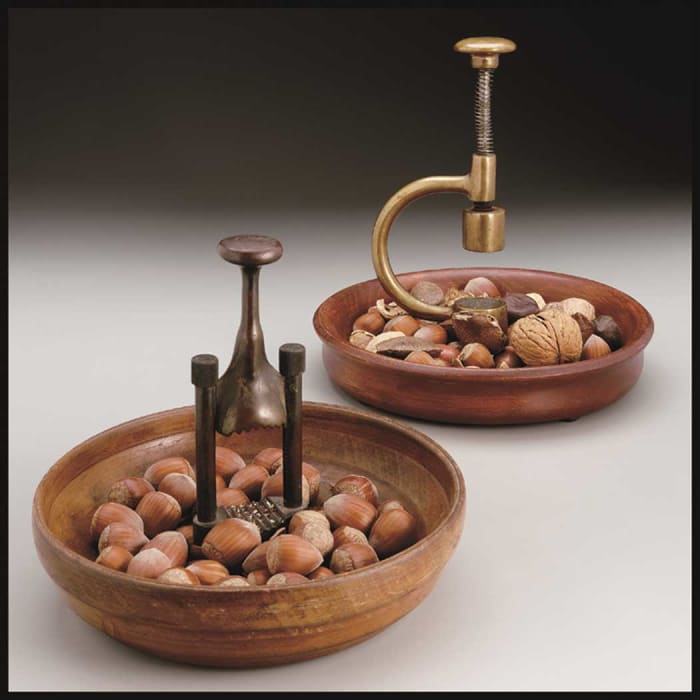For the holidays, stores fill their shelves in the Yuletide section with wooden toy soldier nutcrackers depicting the character so loved in The Nutcracker ballet, which was first performed in Russia in 1892 and has become a holiday tradition. Even so, many keep the utilitarian version in kitchen drawers year ’round.
Nutcracker history
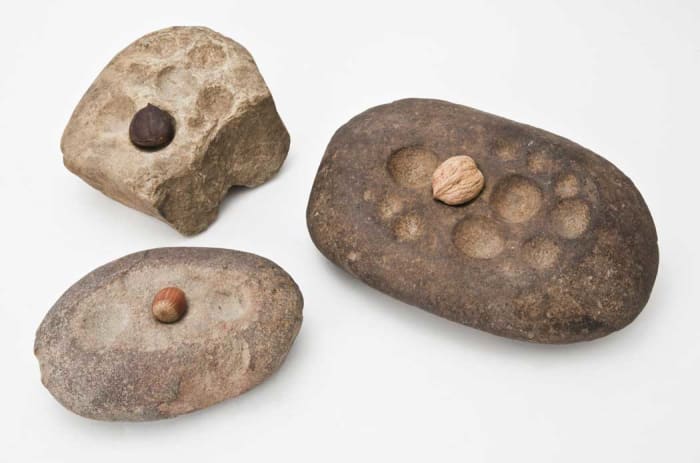
Nutting stones, Archaic Period, United States, multi-dimpled nutting stones (clockwise from top left) conglomerate rock, 6”; brown granite, 10”; conglomerate rock, 7”.
Courtesy of Arlene and George Wagner
Tools used for cracking nuts have existed for thousands of years. The earliest nutcrackers were probably strong teeth or hammers. Archeologists discovered the first evidence that man developed tools to crack nuts at the site of Gesher Benot Ya’aqov, close to the Dead Sea in Israel. There, they found seven varieties of nuts along with some 50 pitted stones reported to be 780,000 years old.
Archaeologists have found similar tools in the United States, dating back 4,000 to 8,000 years, in Louisiana, Alabama, Arkansas, and Ohio. Archeologists have discovered nutting stones equally as old in what is now the Sahara Desert. (Nine thousand years ago, monsoon rains would soak the Sahara, supporting lush vegetation – including nuts. It wasn’t until much later that the climate changed, and the Sahara became a desert.)
The oldest metal nutcracker known dates to the 3rd-4th century B.C. Arlene Wagner, the “Nutcracker Lady” from the Nutcracker Museum in Leavenworth, Washington, says that the “Bronze Hands,” as it was dubbed, was discovered in 1930 in a grave near Taranto, Italy. It is currently exhibited at The National Archeological Museum of Taranto, in Taranto, Italy.
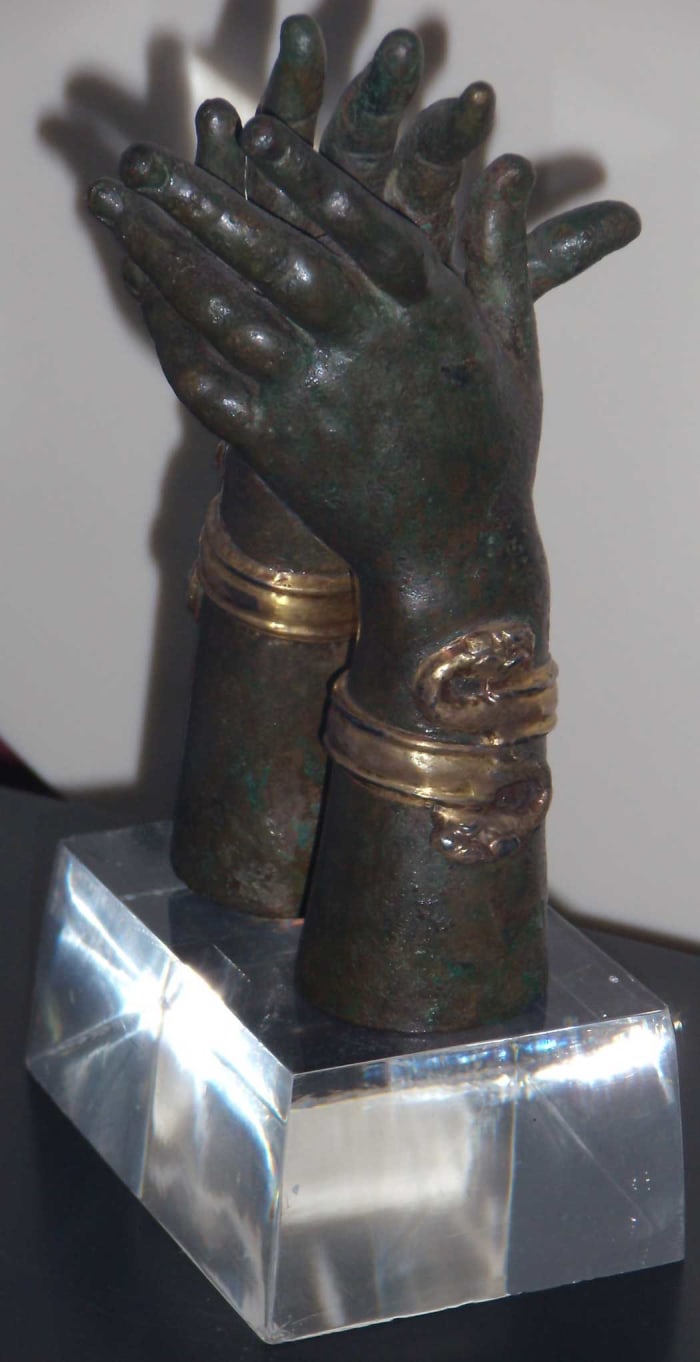
‘Bronze Hands’ is an ancient Greek nutcracker in gilded bronze, dating to the early 3rd century or late 4th century B.C.
Courtesy of the National Archaeological Museum of Taranto, Italy
The journey in learning about these antique nutcrackers is fascinating.
The “Bronze Hands” is an exquisite piece of art, but other ones from artisans throughout time reveal such ingenuity and skill. You will wonder why you only knew about the wooden toy soldier nutcracker.
Types of nutcrackers
Lever nutcrackers
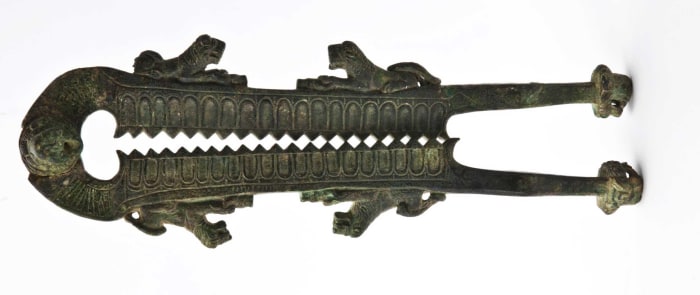
A 14-inch Roman bronze nutcracker – the oldest nutcracker in the museum, dating between 200 B.C. and 200 A.D. – was found in the remains of a villa between Rome and Naples, Italy.
Courtesy of Arlene and George Wagner
Leather straps or (later) metal hinges fastened together two pieces of wood for primitive lever nutcrackers. Nuts were small then like the uncultured hazelnuts.
When men eventually created early nutcrackers, they had small apertures for them. As horticultural methods improved, the nuts increased in size and nutcrackers required larger apertures.
There are basically three types of nutcrackers: lever, screw and percussion using different materials. The lever nutcracker represents the utilitarian one commonly found in today’s kitchens, with a centered fulcrum.
Screw nutcrackers

Male and female screw-type nutcracker from the late 1800s. Noted collector Mike Pickwick believes the nutcracker, just under 9″, was carved as a love token in the Black Forest of Switzerland.
Courtesy of the Mike and Linda Pickwick Collection
After the lever nutcrackers comes the screw type. Arlene Wagner, who co-founded The Nutcracker Museum in Leavenworth, Washington, with her husband George, says that the early screws were usually small and men carried them in their pockets. Most were made of iron, but some were made of brass or silver, allowing for more intricate detail. Wagner says, “The cutting blades to make metal screw nutcrackers were not invented until the 15th century.” But many metal nutcrackers were lost in history because during the wars metal was melted down for supplies.
The earliest-known dated wood screw nutcracker appeared in England in 1631. It measures 3” tall and is carved of boxwood. It is elaborately carved with foliage decoration.
“Wood working lathes for screws were not patented until 1760 in England,” Wagner says. “Before that time wood screws would have been carved by hand.”
Percussion nutcrackers
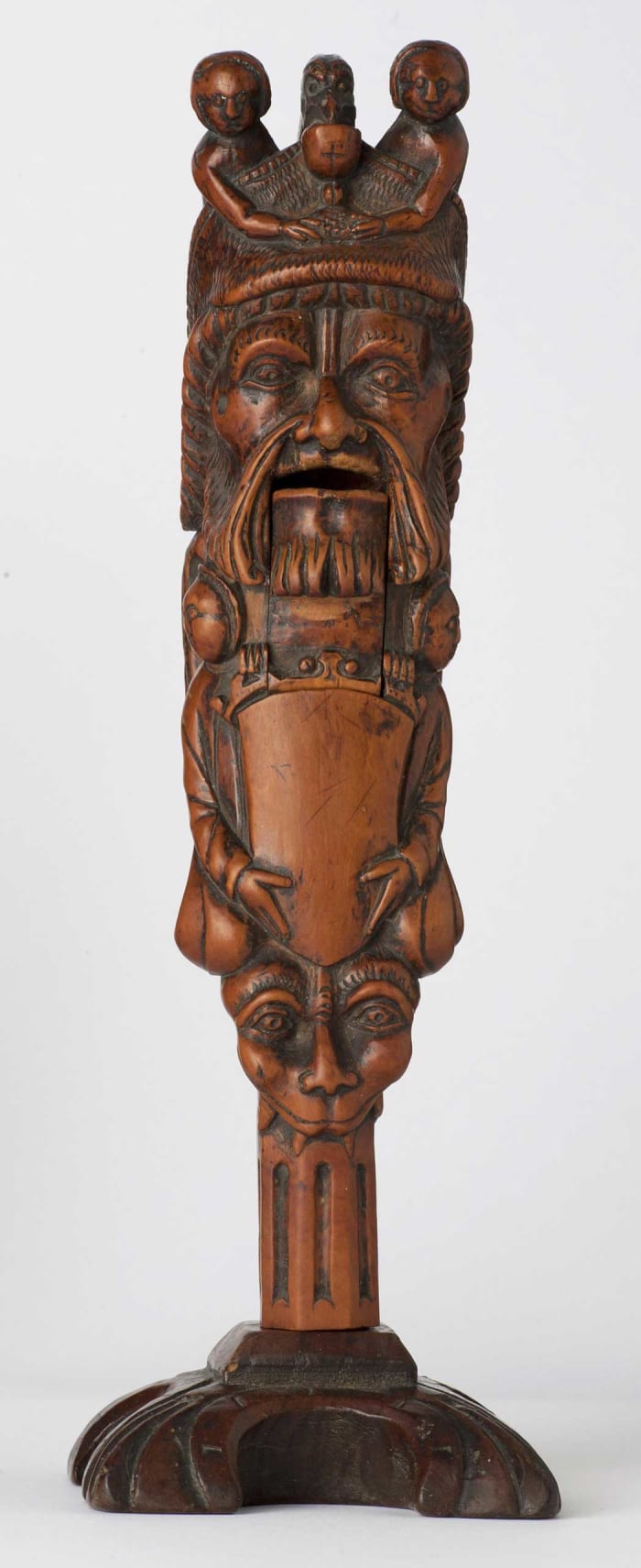
This decorative figural nutcracker with original base, circa 1500 from France, is Arlene Wagner’s favorite lever nutcracker. The boxwood carved nutcracker is 10″ tall.
Courtesy of Arlene and George Wagner
A percussion nutcracker is a type where an object strikes the shell to crack it. Wagner says, “In civilized times, the hammer has been the most common of all percussion tools to crack open the hard shell of a nut.” Found in the Soloman Islands with an unknown origin date is a primitive rock hammer with a wooden handle bound together by a type of weaving material.
In 1850 in America, a craftsman invented the percussion-type nutcracker known as the “knee warmer.” Wagner says, “This was a curved cast iron base that fit over the upper leg. A raised, curved pedestal in the middle of the base held the nut” while a man would hit it with a hammer. It did not hurt his leg, for the pressure was spread over the larger area. Wagner says that men would prefer a wooden hammer to a metal one because then they be less likely to crush the kernel.
A plunger device or rock also served as a type of percussion instrument. The plunger is often decorated in the nutcracker.
When considering the practicality of the three nutcracker types, the screw nutcracker has an advantage over the percussion and lever types because it is easier to get the whole kernel of the nut. Twisting the handle of the nutcracker slowly controls the force on the nut, preventing kernel damage.
The Nutcracker Museum
Wagner can introduce you to a vast array of nutcrackers with her coffee table books. Available titles include The Art and Character of Nutcrackers published in 2005, and An Addendum to the Art and Character of Nutcrackers produced in 2014. For beginning adult collectors, there is The Nutcracker Lady’s Introduction to Nutcrackers.
Wagner didn’t collect nutcrackers when she was young. In the 1970s and ’80s, she was the artistic director of a small ballet company in Renton, Washington. The company produced The Nutcracker ballet each year. She says, “Like Clara in the story, I became entranced with the toothy, wooden nutcracker.” Her husband, at the same time, became fascinated with the toy soldier nutcrackers and they started collecting.
Wagner says, “The first antique nutcracker we purchased was a carved Swiss lever we found at an antique show, and that was the spark that started our interest in the antiques.”
They had no idea of the number of antique nutcrackers that existed. After the discovery, Wagner says, “We were hooked!” They crossed Europe and America for them. They became acquainted with the many of the artisans in the Germany’s Erzgebirge region and collectors elsewhere and read much about nutcrackers.
Friends help build nutcracker collection
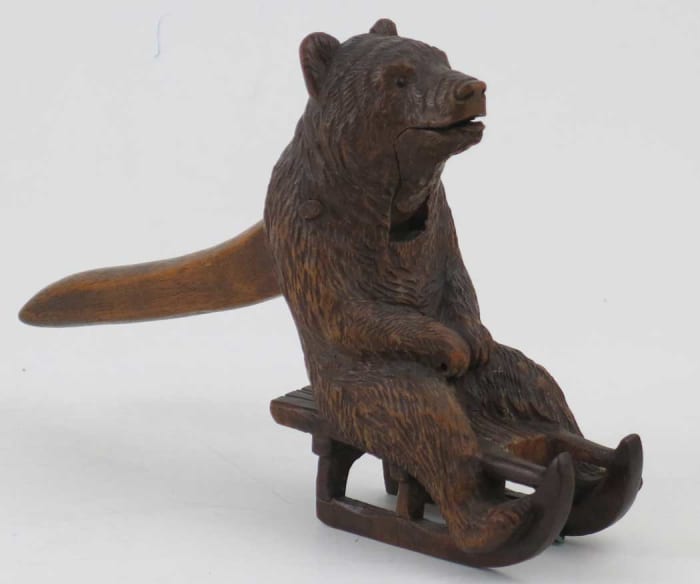
Bear on sled nutcracker from late 19th century Switzerland made out of beech wood, five inches tall.
Courtesy of Arlene and George Wagner
Friends would call them about special ones. Wagner was sleeping soundly one evening when the phone rang. Her European antique dealer friend greeted her with: “I found a nutcracker for you. You must have it. It is a bear on a sled.”
Wagner responded, “Rik, have you been drinking? Bears do not use sleds.” He replied that indeed it was a bear on a sled from Switzerland. Then she took it.
The Wagners amassed quite a nutcracker collection. In 1993, they bought a building in Leavenworth, Washington. Filling it with their collection, they opened the Nutcracker Museum in 1995.
Nutcracker Museum holdings
Representing 50 countries, the museum holds more than 7,000 nutcrackers. Holdings include the pervasive wooden toy soldier type we’ve come to associate with Christmas, and many other antique examples.
Two of the oldest nutcrackers in the Leavenworth Nutcracker Museum are lever type nutcrackers. The oldest is a rare Roman bronze nutcracker that dates to between 200 B.C. and 200 A.D. It was discovered in 1960 in the remains of a Roman villa between Rome and Naples. Wagner says, “We know of only two other nutcrackers in existence to have come from this period of history.”
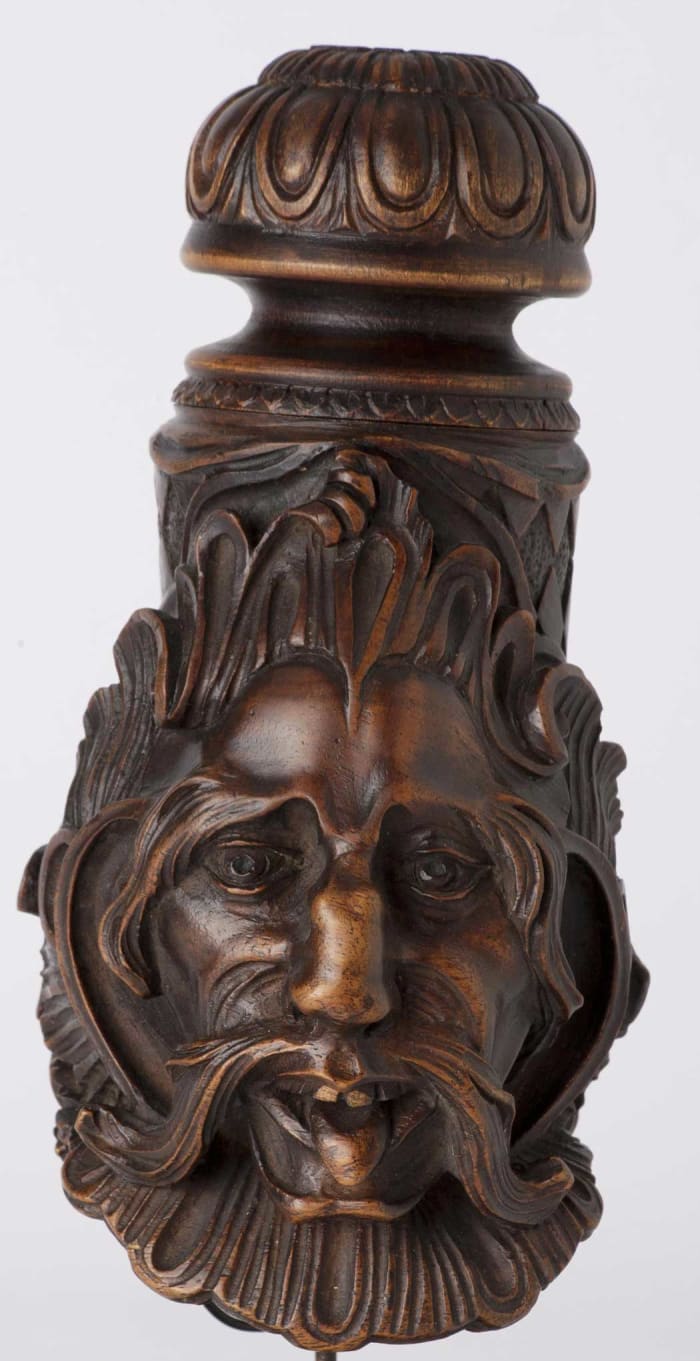
A superbly sculpted court jester – Ms. Wagner’s favorite screw nutcracker – from 19th century, Italy.
Courtesy of Arlene and George Wagner
Also in the museum are two metal lever nutcrackers circa 12-13th century. Made in France of hand-forged iron, they measure 6 inches long. The ends are abstract ducks. One was found buried in Romania. Wagner says it is believed that the Crusaders dropped the nutcracker as they traveled east to the Holy Lands. Wagner also shares that a museum in France, Musee Le Secq des Tournelle of Rouen has on display an impressive collection of hand-wrought iron nutcrackers dating back to the 13th century. It may be the world’s largest collection of nutcrackers.
Nutcracker materials
Most nutcrackers are made of materials such as metals – iron, brass, silver – or wood. But some craftsmen have produced them in fragile materials such as ivory, bone, and porcelain that have actually survived. The problem with these is that although they are easy to carve, they are not strong enough to endure the rigors of cracking hard-shelled nuts. Most often, you will find these materials incorporated as part of the nutcracker. You can find these, too, at the Leavenworth Nutcracker Museum.
Karl, The Nutcracker Museum mascot
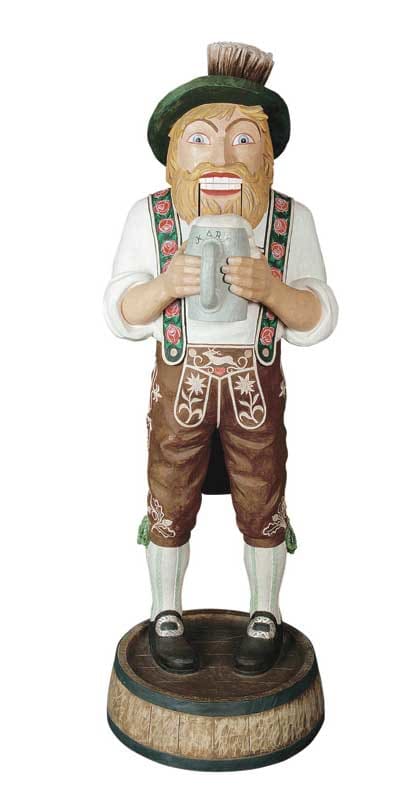
Karl the Ambassador, The Beer Drinking Bavarian, 21st century, Oberammergau, Bavaria, Germany, carved by Karl Rappl from one piece of linden wood, except for the lever which opens the mouth. Karl is 6 feet tall and was specially made for the Wagners’ museum.
Courtesy of Arlene and George Wagner
The museum, a 501(c)3 non-profit, has benefitted from benefactors other than the Wagners, who officially donated their personal collection to the museum shortly after its opening. Carver Karl Rappl of Oberammergau, Germany, has made three special nutcrackers specifically for the Leavenworth museum. One is of Arlene Wagner, one is of George, and the final one is of their ambassador, Karl. Karl is a 6-foot carved nutcracker of a beer-drinking Bavarian. Rappl had previously carved a 6-foot clown nutcracker that the Wagners loved. They asked if he could make a Bavarian nutcracker for them. It took him 18 months to complete and ship it to the United States. Rappl carved Karl, the museum’s mascot, from a single piece of Linden wood. (Except for the lever.) You can imagine everyone wants a photo with him!
Rappl says the museum is a fun place to visit, but the museum’s mission is clear. As stated in its mission statement, the staff wants everyone to understand “the importance of nuts in the diets of humans throughout history and in the evolution of the nutcracker.”
Wagner explains, “No other tool or collectible has shown such a wide diversity of material and design as the implements used to crack the hard shell of the nut.” She adds, “Many factors – from purely practical to purely stylistic and expressive – have contributed to the evolution of the nutcracker form, functionality, and character. These factors include advances in production techniques, the availability of materials, styles of the times, consumer demand, and even changes in the nuts themselves.”
The Pickwick nutcracker collection
Mike Pickwick and his wife, Linda, are also avid carved wood nutcracker collectors. They have collected antiques since the 1970s and have since discovered the love of antique nutcrackers. They find the book Ornamental and Figural Nutcrackers: An Identification and Value Guide a helpful resource.
The Pickwicks first purchased a carved wooden nutcracker, an eagle with glass eyes, at local antique show. Their oldest is from 1690: a barrel-type screw nutcracker with the date faintly carved on the barrel. [Mike learns much from the Nutcrackers Collector’s Club newsletters.]
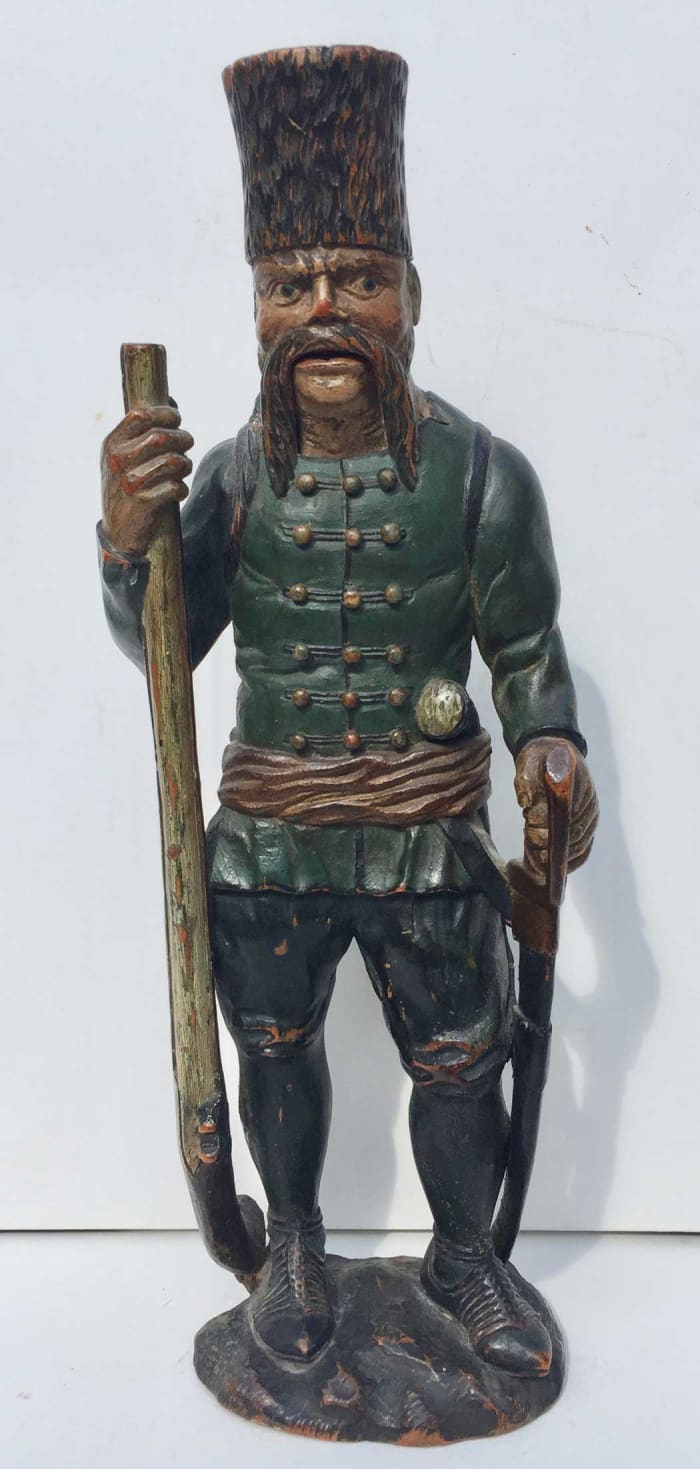
This painted soldier nutcracker is Mike Pickwick’s favorite. The nutcracker is from mid-1800 France and stands 10-1/2”. The lever nutcracker cracks a nut by lifting the knapsack on the back.
Courtesy of the Mike and Linda Pickwick Collection
Mike cares for his wooden nutcrackers by using a quality paste wax such as Minwax Finishing Paste Wax. He says, “I generally wax our pieces every three months, or so as needed. Polishing brings out a rich deep patina on the piece. It prevents drying and cracking.”
A tidbit Mike has learned about wooden antique nutcrackers along the way is that although master carvers would only produce the elaborately carved nutcrackers for the wealthy and royalty, the other classes enjoyed nutcrackers, too.
Pickwick says, “Peasants would carve nutcrackers as love tokens, for personal use, and to sell at fairs, and as gifts.”
The European carving tradition
Of the European carving tradition, Wagner says, “By the 15th and 16th centuries, carvers in France and England were creating beautiful wooden nutcrackers.” Artisans would use woods from their locales, such as fruitwood, lignum vitae, maple, beech, and walnut. Many preferred boxwood because of the fine grain and uniform color.
Because life was simpler centuries ago, master carvers could spend time on these for the wealthy and royalty. Subjects included the royalty themselves, political figures, animals, book characters, and townspeople. Wagner says that royalty would treat master carvers as famous painters and composers at court. Because household staff would take care of the nobles’ nutcrackers, they stood the test of time.

A 1750s lever nutcracker from France carved from fruitwood standing 9-1/2″.
Courtesy of the Mike and Linda Pickwick Collection
The Anri Company
Anri is an Italian company famous for its carved wood nutcrackers. In the 19th century, before men had constructed paved roads and even railways in Italy’s Groden Valley, local wood carvers would trek across mountainous passes to sell their wares in European markets. Anton Riffeser (born 1887), of St. Christina in Groden Valley, learned carving from his father. Riffeser joined Austria’s Tyrolean Guard when World War I broke out. He fought at the Russian Front.
The Russians captured Riffeser and sent him to a Siberian prisoner of war camp. While there, Riffeser and his friends practiced their carving skills, often using Russian peasants as models. During his imprisonment, Riffeser devised a plan for his company and learned English. When the war ended, he and his friends returned to the village of St. Christina ready for business. He founded the Anri company in 1920.
Anton named his company Anri using the first two letters of his first and last names. The business grew rapidly and the company produced many types of painted figural lever nutcrackers, as well as other wood carvings. You can see many of the Anri nutcrackers in the book, Anri Woodcarvings (Schiffer, 2001) by Philly Rains and Donald Bull.
Nutcracker collectibility and values
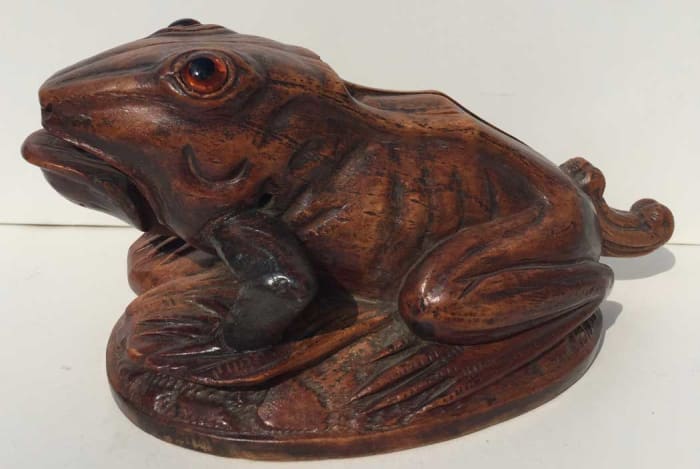
A late 19th century frog nutcracker carved in France out of fruitwood stands 4″ tall and 7″ long. Place a nut in the frog’s mouth and lift the lever tail to crack it.
Courtesy of the Mike and Linda Pickwick Collection
Nutcrackers are not as popular as they once were. But there are still those who love to collect different characters of the wooden toy soldier type, and those who collect different figural nutcrackers.
There are no limits to the forms that nutcrackers take. For example, find a walnut-shaped nutcracker in Germany. And ibex and dragon nutcrackers in Russia.
Other creative antique nutcrackers feature glass and ivory eyes. One nutcracker from Anri has eyes that change colors from blue to brown when you lift the lever.
Some include whistles in the levers, presumably to call the servants to bring the nuts. Victorian era carvers designed walking sticks with nutcrackers.
Nutcracker values
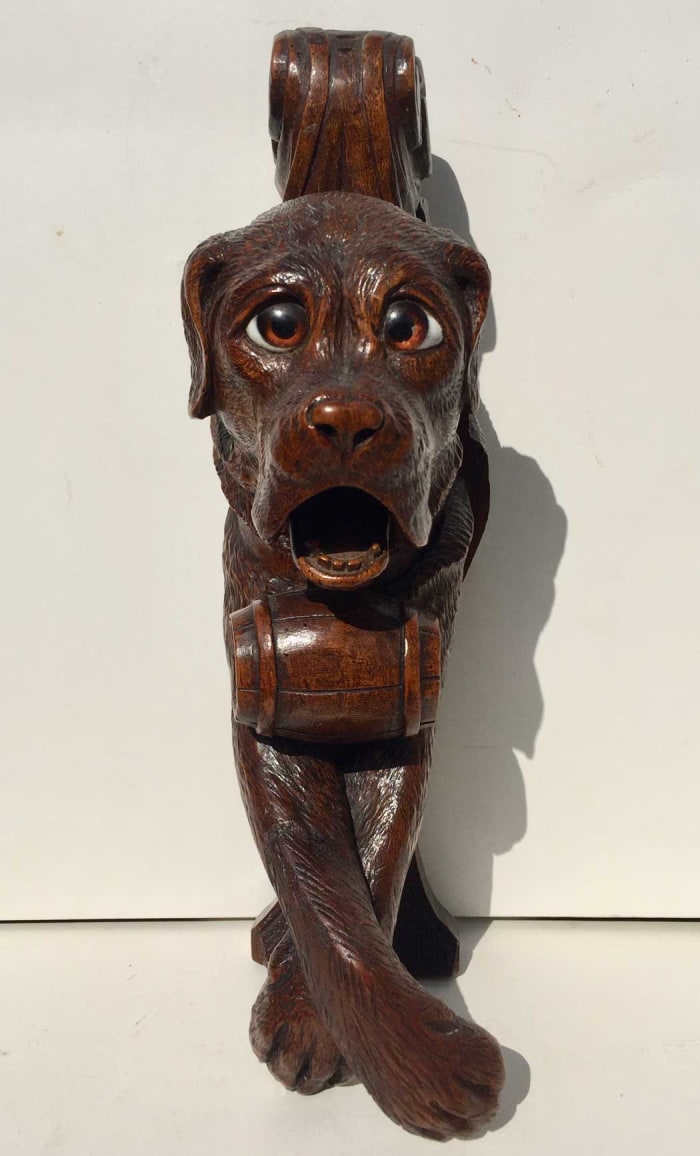
A dog nutcracker, late 1800s, carved for Paris Exposition, France, out of hardwood, 10-1/2” tall.
Courtesy of the Mike and Linda Pickwick Collection
The quality of the construction, the materials, and condition all affect value. As do the maker and age of the nutcracker. Even very old nutcrackers don’t have to cost a lot of money. At the lower end of the price spectrum, an Anri nutcracker in the form of a monk with some surface wear to the paint sold for $30.
One can buy many different types of quality antique nutcrackers for a few hundred dollars. For example, a pair of 1881 Sheffield English silver nutcrackers sold in February 2012 for $300. An 1800s folk art wood screw press nutcracker with a ram’s head, in excellent condition, sold in October 2012 for $275.
Walking stick nutcrackers are unusual to find, but still relatively affordable. In August 2016, a 19th century carved beech gadget cane with screw nutcracker sold for $300. Also, a circa 1890 English hooded monk screw nutcracker cane sold for $900 in April 2013.
Creeping up in value, perhaps because of its fragility, an antique Meissen porcelain and brass screw nutcracker from the late 19th century, in overall to fair condition, sold in November 2011 for $750.
Some antique percussion nutcrackers are hard to find, yet still not very expensive. A carved bone Alaskan percussion nutcracker sold for $220 in December 2014. A circa 1900 cast iron percussion nutcracker, titled “Tough Nut,” in a form of a sailor seated on a coil of rope, in very good condition sold for $250 in November 2017.
Time to get cracking
Although many are available, you don’t have to buy a lot of nutcrackers to enjoy them. Travel to Washington and meet the Nutcracker Lady and Karl, and surround yourself with the wonderful world of colorful nutcrackers. Then go home and celebrate the holidays with nuts and a nutcracker or two over a bowl with friends.


